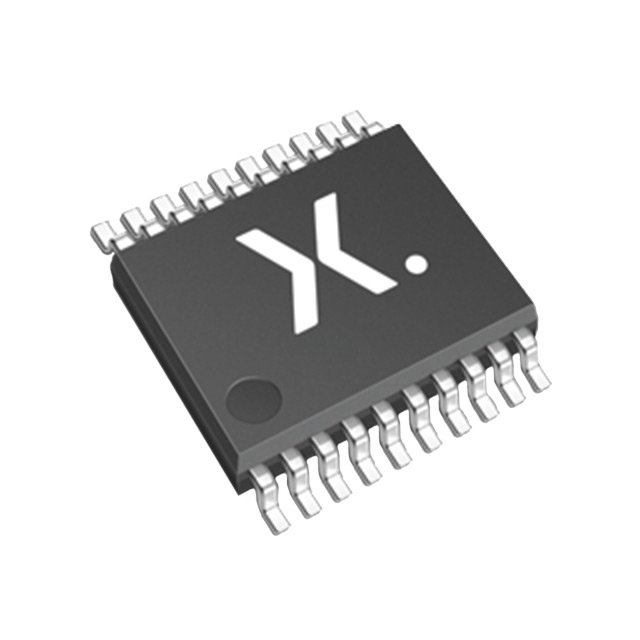74LVC574APW,118
Product Overview
- Category: Integrated Circuit (IC)
- Use: Flip-Flop
- Characteristics: Low-voltage CMOS Octal D-type Flip-Flop with 3-State Outputs
- Package: TSSOP (Thin Shrink Small Outline Package)
- Essence: This IC is designed to store and transfer data in electronic circuits.
- Packaging/Quantity: Tape and Reel, 2,500 pieces per reel
Specifications
- Supply Voltage Range: 1.65V to 5.5V
- High-Level Input Voltage: 0.7 x VCC
- Low-Level Input Voltage: 0.3 x VCC
- High-Level Output Voltage: 0.9 x VCC
- Low-Level Output Voltage: 0.1 x VCC
- Maximum Operating Frequency: 125 MHz
- Number of Flip-Flops: 8
- Output Type: 3-State
Detailed Pin Configuration
The 74LVC574APW,118 IC has a total of 20 pins. The pin configuration is as follows:
- GND - Ground
- D0 - Data Input 0
- D1 - Data Input 1
- D2 - Data Input 2
- D3 - Data Input 3
- D4 - Data Input 4
- D5 - Data Input 5
- D6 - Data Input 6
- D7 - Data Input 7
- OE - Output Enable
- CP - Clock Pulse
- MR - Master Reset
- Q0 - Output 0
- Q1 - Output 1
- Q2 - Output 2
- Q3 - Output 3
- Q4 - Output 4
- Q5 - Output 5
- Q6 - Output 6
- Q7 - Output 7
Functional Features
- Octal D-type flip-flop with 3-state outputs
- High-speed operation, suitable for various applications
- Low power consumption
- Compatible with TTL levels
- 3-state outputs allow multiple devices to share a common bus
Advantages and Disadvantages
Advantages: - High-speed operation enables efficient data transfer - Low power consumption helps in energy-efficient designs - Compatibility with TTL levels allows easy integration into existing circuits - 3-state outputs facilitate bus sharing among multiple devices
Disadvantages: - Limited voltage range (1.65V to 5.5V) - Not suitable for high-frequency applications above 125 MHz
Working Principles
The 74LVC574APW,118 is an octal D-type flip-flop that stores and transfers data based on clock pulses. The inputs (D0-D7) hold the data, which is transferred to the outputs (Q0-Q7) when the clock pulse (CP) is triggered. The output enable (OE) pin controls whether the outputs are active or in a high-impedance state.
Detailed Application Field Plans
The 74LVC574APW,118 IC finds applications in various electronic systems, including but not limited to: - Data storage and transfer in microcontrollers and microprocessors - Address decoding in memory systems - State machine design - Bus interface circuits - General-purpose digital logic circuits
Detailed and Complete Alternative Models
Some alternative models that can be considered as replacements for the 74LVC574APW,118 IC include: - SN74LVC574A from Texas Instruments - MC74LVX574 from ON Semiconductor - CD74HCT574 from Texas Instruments - 74HC574 from NXP Semiconductors
These alternative models offer similar functionality and can be used as drop-in replacements in most applications.
Word count: 346 words
Lista 10 Vanliga frågor och svar relaterade till tillämpningen av 74LVC574APW,118 i tekniska lösningar
Sure! Here are 10 common questions and answers related to the application of 74LVC574APW,118 in technical solutions:
Q: What is the function of the 74LVC574APW,118? A: The 74LVC574APW,118 is an octal D-type flip-flop with 3-state outputs. It can store and transfer data in digital circuits.
Q: What is the operating voltage range for the 74LVC574APW,118? A: The operating voltage range for this IC is typically between 1.65V and 5.5V.
Q: How many flip-flops are there in the 74LVC574APW,118? A: The 74LVC574APW,118 has 8 flip-flops, making it an octal (8-bit) device.
Q: What is the maximum clock frequency supported by the 74LVC574APW,118? A: The maximum clock frequency supported by this IC is typically around 125 MHz.
Q: Can the 74LVC574APW,118 be used for bidirectional data transfer? A: No, the 74LVC574APW,118 is a unidirectional device and can only transfer data in one direction.
Q: What is the power supply current requirement for the 74LVC574APW,118? A: The power supply current requirement varies depending on the operating conditions, but it is typically around 4 mA per flip-flop.
Q: Does the 74LVC574APW,118 have internal pull-up or pull-down resistors? A: No, this IC does not have internal pull-up or pull-down resistors. External resistors may be required for proper operation.
Q: Can the 74LVC574APW,118 tolerate overvoltage on its inputs? A: No, this IC is not designed to tolerate overvoltage on its inputs. It is recommended to stay within the specified voltage range.
Q: What is the typical propagation delay of the 74LVC574APW,118? A: The typical propagation delay for this IC is around 5 ns, but it can vary depending on the operating conditions.
Q: Is the 74LVC574APW,118 suitable for high-speed applications? A: Yes, the 74LVC574APW,118 is designed for high-speed operation and can be used in various high-frequency digital circuits.
Please note that the answers provided here are general and may vary depending on specific datasheet specifications and application requirements.


